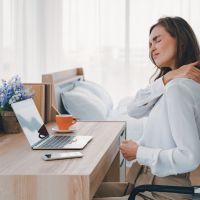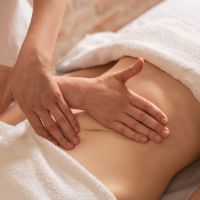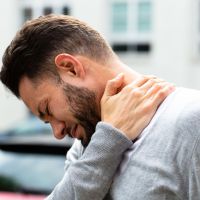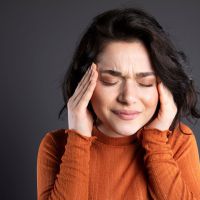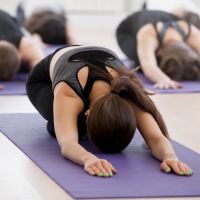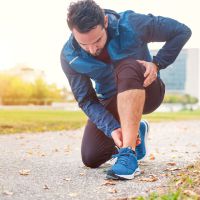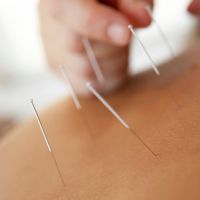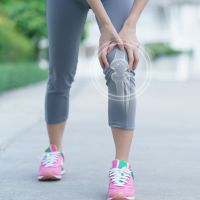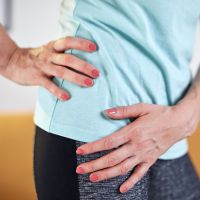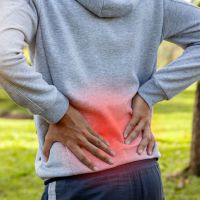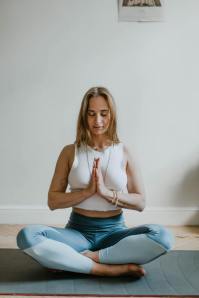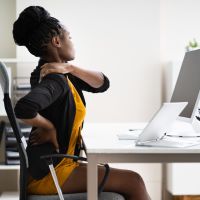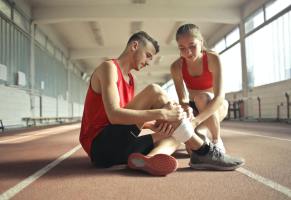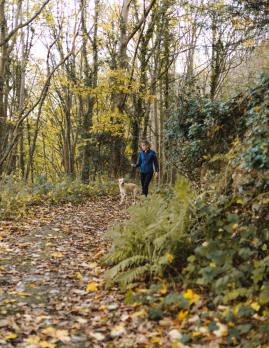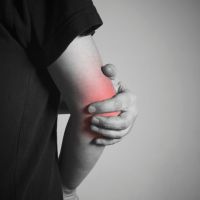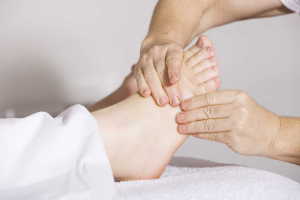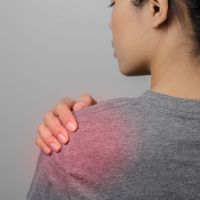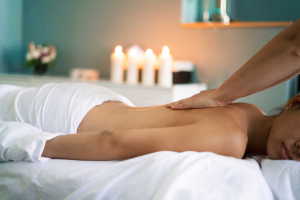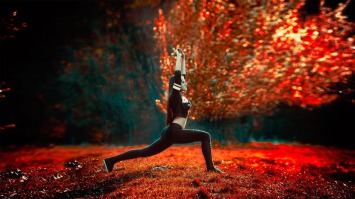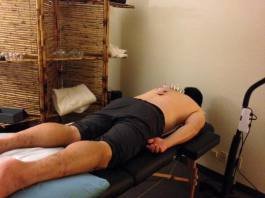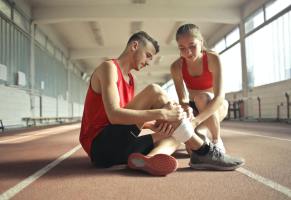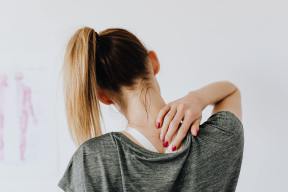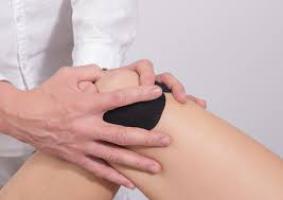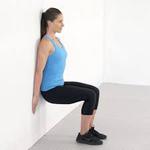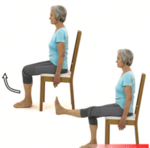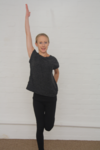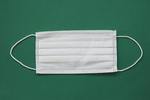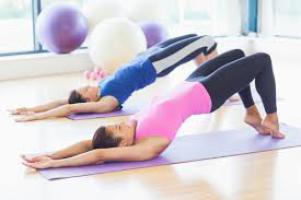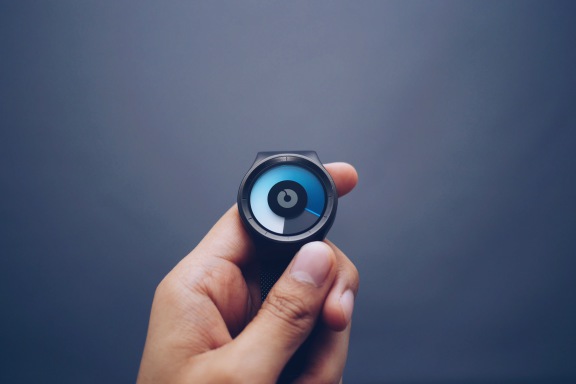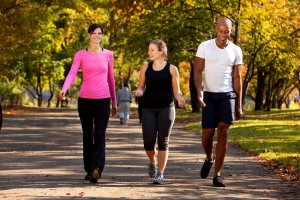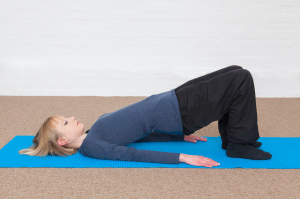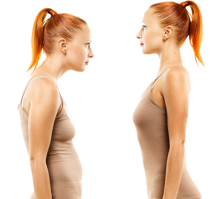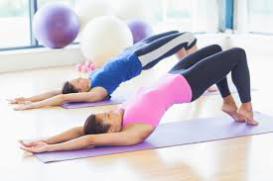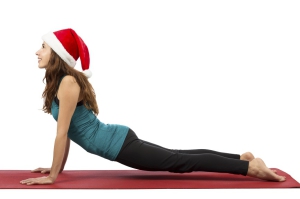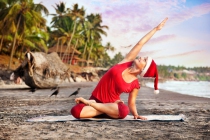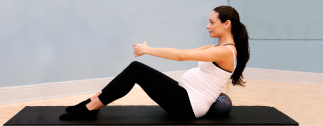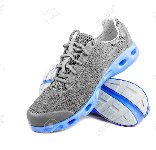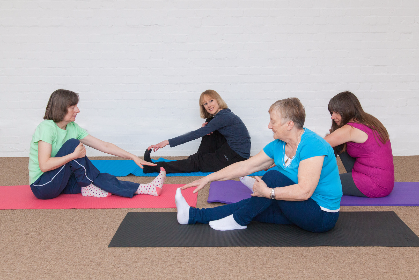Blog articles & Offers
For monthly articles, advice and offers subsribe to the monthly newsletter here.
Help for Women With Upper Back Pain
Common causes, prevention tips, and how physiotherapy can help women with persistent back pain.
Back pain affects many of us ladies and there are specific factors for women that contribute to our risks of getting back pain. Here are some tips to help prevent and get on top of recurrent back pain:
Wear a good bra - wearing the wrong size or an unsupportive bra increases the load on your upper back. Wearing a good fitting bra is especially important during exercise and even more so for larger women.
Mums - Vary how you carry your babies and children - repeatedly carrying your children on one side can cause muscular imbalances to occur, which in time can cause pain or overuse injuries. Be mindful of how you lift your children too, bending your knees if bending forward and lifting them up to avoid straining your back.
Avoid excessively heavy bags and wear cross body bags or backpack type bags when you have a lot to take with you. Carrying lots of unnecessary stuff can be the equivalent of walking around with some dumbbells in your bag. Aim to regularly go through your bag and take out things you don’t need. Ensure your bag feels comfortable on your back and adjust it if possible to keep it closer to your body.
Pregnancy and postnatal related back pain - get assessed! There are many causes of back pain in pregnant and post-natal women. The postural, hormonal and lifestyle changes women go through can all contribute to added strain on the muscle and joints of the spine. An individualised assessment, treatment and exercise programme is key to easing and preventing pain.
Menopause related LBP - also get assessed - as for pregnant women the postural, hormonal and lifestyle changes women go through during menopause can all contribute to added strain on the muscle and joints of the spine. Reduced levels of oestrogen can slow the rate of tissue repair and recovery meaning aches and pains linger for longer. An individualised assessment, treatment and exercise programme is key to easing and preventing pain. To contact and book an appointment email me: claairegurneyphysio@gmail.com, tell me about your symptoms and ill explain how i can help you.
July Therapy of the Month: TMJ Physio
Jaw Pain (TMJD): Symptoms, Causes, and Treatments
This month’s therapy of the month is TMJ Physiotherapy
If you are dealing with facial pain or headache, experiencing jaw pain while talking or eating, or feeling like your teeth are misaligned without any clear reason, you might be suffering from TMJD. This little-known condition can feel horrible, confusing and never ending. However it doesn't have to be this bad forever. Physiotherapy is a proven approach to alleviate pain, enhance jaw function, and improve your overall quality of life.
TMJD, or temporomandibular dysfunction, affects the joints, muscles, and soft tissues of the jaw. It can lead to facial pain, neck and shoulder discomfort, headaches, jaw clicking, tinnitus, facial muscle tightness, and a host of other symptoms.
TMJD is an often overlooked and poorly understood condition that can be the underlying cause of various common symptoms. The TMJ, or temporomandibular joint, is the hinge connecting your lower jaw to your skull. Problems with this joint can cause pain or clicking and popping sounds, indicating issues with the TMJ and the surrounding muscles, ligaments, and tissues.
When the TMJ fails to function properly, it is termed TMD (temporomandibular dysfunction) or TMJD. This can result in:
· Facial pain
· Limited mouth opening
· Teeth grinding (bruxism)
· Headaches
· Dizziness
· Muscle spasms and tension
· Referred pain to the neck, shoulders, and back
· Hearing problems and tinnitus
· Blurred vision
TMJD is often addressed by dentists or oral surgeons who may recommend pain relief medications or splints/devices to prevent teeth grinding. While focusing on teeth and occlusion is important, it often overlooks the muscles and soft tissues around the joint, which are frequently the primary source of pain.
Available Treatments for TMJD
Physiotherapy aims to relieve pain and restore normal movement and function at the TMJs. TMJ physiotherapy primarily targets the jaw, neck, and shoulders, but if there are additional postural issues in the back or hips, these areas are also treated. A combination of hands-on treatments (such as massage, acupuncture, and myofascial release) and exercise rehabilitation is used. Research has shown that physiotherapy can significantly reduce facial pain, headaches, and other TMJD symptoms, decreasing the need for surgery, dental procedures, and other irreversible treatments.
Each person with TMJD will have different symptoms and causes of their issues. An individualised assessment and treatment plan is key to resolving and managing symptoms long term. To find out more or book an appointment for TMJ physiotherapy, get in touch.
June Therapy of the Month: Pilates
Pilates is a holistic exercise system that benefits both the body and mind. Developed by Joseph Pilates in the early 20th century, this method of exercise focuses on core strength, flexibility, and mindful movement. The main advantage of Pilates is its ability to enhance overall fitness without the strain associated with high-impact exercises. By encouraging controlled movements and proper breathing techniques, Pilates helps to build a strong, balanced body. This, in turn, can improve posture, alleviate chronic pain and reduce the risk of injury.
Pilates is a highly adaptable method of exercise, making it suitable for individuals of all fitness levels and ages. Whether you love exercise or are just beginning your fitness journey, Pilates exercises can be adapted or progressed to meet your needs and levels of fitness, ensuring that everyone can benefit from practicing. This adaptability also makes Pilates an excellent choice for rehabilitation after injury, as it promotes gentle yet effective strengthening and flexibility. By regularly taking part in Pilates, individuals often notice an increase in muscle tone, endurance and overall fitness.
Beyond the physical health benefits, Pilates also benefits mental health. Pilates encourages a mind-body connection that fosters a greater awareness of how your body moves and feels. This can reduce stress, enhance concentration and promote a sense of calm and wellbeing. Pilates sessions often incorporate elements of body awareness and deep breathing, which can help to quiet the mind and alleviate anxiety. By integrating Pilates into your routine, you not only work towards a healthier body but also cultivate a more balanced and serene state of mind.
If you would like more information on Pilates 1:1 sessions and/or small group classes get in touch: info@clairegurneypilates.com
Breathing Exercises for Back Pain, How and Why.
Pain, stress and anxiety
It may seem obvious that chronic back pain will lead to stress and anxiety, being in pain is stressful! However this also works in reverse - over time there is a chance chronic stress can lead to back, neck and even shoulder pain. This is not one of those “it’s all in your head” conversations that suggests a psychological cause of pain but an explanation of how our nervous system’s response to stress affects us on a physical and anatomical level.
When we become stressed, be it from work, a difficult home situation or a significant life event, we experience a fight or flight response causing increased muscle tension (as though preparing us to fight a tiger!), an elevated heart rate and increased breathing rate. If the stress doesn’t go away we become chronically stressed and the changes in muscle tone and breathing mechanics (a shallower more rapid breath pattern) also persist.
The anatomy
The diaphragm, intercostal and accessory muscles control the movement of our ribcage when we breathe. The diaphragm also has a secondary role as a core stabilising muscle, working alongside our abdominal, pelvic floor and spinal muscles to support our body’s posture. If the diaphragm is not able to contract and lengthen through its full range of movement, as a consequence of a shallow stressed out breathing pattern, other core muscles will be affected and fatigue more easily - including our spinal muscles.
If our back muscles are already tense from the flight or fright response and overworked from a lack of diaphragm activity in our core stability ‘cylinder’ then they will become tight and painful. Similar issues can happen at the neck and shoulder (but that is beyond the scope of this blog). If you have been struggling with back pain and chronic stress for a while, and found that traditional back exercises and/or rest haven't solved the problem, it may be worth trying another approach.
How can breathing exercises help?
So what is this approach? Put simply, breath work and relative relaxation in addition to more traditional physiotherapy. By relative relaxation I mean doing something that allows you to switch off your brain and have some down time on a daily basis to get out of ‘fight or flight’ mode - this may be walking, swimming, reading, meditating… something that you enjoy and allows your nervous system to have a break.
Daily breath work can be as simple as slow deep breathing practiced at a set time each day. Yoga breath patterns, Pilates breathing and practicing Hypopressives are all good ways to allow your diaphragm to start to move through its full range of movement. In turn allowing your core muscles to work more effectively during exercise and daily life.
I’m still working on incorporating and explaining this approach to clients in physiotherapy sessions and putting it all down in blog form allows for it to be revisited and re-read to understand why I’ve given them breathing exercises, whilst also educating others who may be interested.
How physiotherapy can help with back pain
Back pain is one of the most common medical problems worldwide, affecting about 80% of people at some point in their lives. There are many causes of back pain, ranging from muscle or ligament strains, herniated discs and arthritis to more serious conditions like spinal stenosis or fractures. Poor posture, a sedentary lifestyle and improper lifting techniques increase the risk of developing it.
Back pain can be acute, lasting from a few days to a few weeks, while chronic back pain persists for 12 weeks or longer. Many treatments exist for back pain, non-invasive treatments like physiotherapy, yoga, Pilates and acupuncture are the first line of treatment and are very effective for some individuals.
As a physiotherapist I see a lot of people with back pain, some with acute back pain which has come on after lifting heavy weights in the gym or in their garden, and others with back pain that has persisted for years and either flared up, or gotten significantly worse to the point they need to seek help. I can help with both forms of back pain and take an individualised approach to treatment, as each person will have different physical and situational factors affecting their pain and will have different preferences, needs and goals of treatment.
What to expect during an appointment
During an initial physiotherapy appointment for somebody with back pain I will start by asking some questions about their pain such as where is the pain, when did it start, what have you tried so far? As well as other specific questions to rule out anything serious that needs onward referral. Once I am clear on what might be causing or contributing to their pain I will complete a physical assessment including movement tests (asking the person to complete some movements and exercises), muscle and joint palpation and nerve and reflex testing if indicated. Once I understand what is going on physically for the person I can discuss a likely treatment plan with them involving exercise, lifestyle advice and other treatments such as massage or acupuncture if required.
How many sessions will i need?
Most people will need anywhere from 3-12 follow up sessions to progress and carry out their treatment plan, depending on their diagnosis, if their condition is acute or chronic, how long it has
been present for and their own budget and time commitments. Many people continue to see me for preventative treatments such as Pilates sessions or massage once their pain has resolved.
If you would like to learn more and/or have been struggling with persistent back pain and need some help please get in touch: info@clairegurneypilates.com
Help for Elbow and Wrist Pain.
Elbow and wrist pain can be debilitating and interfere significantly in day-to-day tasks. Opening jars, using a computer and even writing with a pen can all become difficult to do and lead to frustration with what might seem like such a small injury.
For some people, the cause of your pain might be clear, you might have fallen on your arm or sustained a sports injury. For many people it isn’t so obvious, as Repetitive Strain Injuries (RSIs) are frequently encountered in the elbow and wrist due to repetitive movements and the fact we use these relatively small joints a lot with daily tasks.
Persistent use of your elbow and wrist can result in discomfort along the inner or outer elbow (often referred to as golfer's or tennis elbow). This discomfort arises as the forearm muscles become increasingly tense and overworked, leading to irritation of the tendons and adjacent structures of the elbow. This can also happen from one sudden bout of new or infrequent activity (e.g. playing tennis for hours when you haven’t played for years).
Wrist-related strains and injuries often occur due to continuous repetitive activities like office work or DIY projects, as well as from heavy lifting or exercises that exert pressure on the wrists, such as more intense yoga classes. Carpal tunnel syndrome is another prevalent wrist condition characterised by nerve compression that results in tingling and weakness in the hand and wrist.
Should pain or symptoms such as numbness and tingling persist at your elbow or wrist becoming worse over time, consulting a physiotherapist or GP is important, as timely rehabilitation is important for full recovery.
Who is at risk of getting elbow and wrist pain?
People who take part in activities involving repetitive or strenuous hand or wrist movements and those participating in sports that focus on upper body strength are at higher risk for these injuries.
This includes: Office workers, DIY enthusiasts, Manual workers, Tennis and golf players, Yogis and Gym/fitness enthusiasts and weightlifters
Managing elbow and wrist repetitive strain injuries (RSIs)
1.Prevention
When starting or increasing your time spent doing tasks that primarily involve your upper body, it's important to incrementally increase the time you spend. For example, if taking up gardening or starting to lift weights, begin with short sessions of no more than 20-30 minutes at once, if you want to spend more time, then take regular breaks and slowly extend the activity period over days and weeks.
The approach to exercise should also be gradual, beginning with less intense sessions and gradually increasing the intensity and duration of what you are doing. This helps in building endurance and strength without overstraining.
2.If you have an injury
If an injury becomes particularly painful or debilitating, taking a break from the activities causing pain is recommended. Wearing a wrist brace during strenuous activities and possibly at night might help alleviate discomfort for some people. Applying ice, or alternating between ice and heat treatments for up to 10 minutes several times a day, can provide further relief.
Doing some self-massage on your forearms and engaging in light upper body exercises can initially alleviate symptoms and maintain strength and mobility in the wrist, elbow, and shoulder areas. These exercises can be progressively intensified to aid recovery.
Should pain persist without improvement, book a physiotherapy appointment or GP to obtain a precise diagnosis and a personalised exercise and recovery program.
Why do I have shoulder pain ?
Shoulder pain is a common condition often caused by injury or overuse. The pain can make it difficult to perform routine tasks and activities such as dressing, carrying shopping or driving. Pain is present at the shoulder joint and often refers into your neck and/or down your arm.
Why do I have shoulder pain?
If there was no obvious cause for your pain (e.g. a sports injury or fall onto your shoulder) then your pain is likely to be a consequence of repeated use of the muscles around your neck, shoulder, arm and upper back. It may seem obvious but you use these muscles to maintain posture, perform daily tasks and for many to get your exercise fix. Repeated use (even if not obvious use) can lead to pain.
Commonly affected muscles are the rotator cuff muscles that support the ‘ball and socket’ joint of the shoulder, your upper biceps at your upper arm and the trapezius muscle that is situated around the back of the shoulder and shoulder blade.
Poor posture and shallow breathing can also play a role in the development of shoulder pain, as can a history of shoulder pain. Pain switches off muscle groups so you may have a weakness from previous injuries if you did not have physio or deliberately strengthen your shoulder once pain settled down.
Who is more likely to get shoulder pain?
- People who play sports involving arm movements: swimmers, tennis players, paddle boarders.
- Office workers who have a poor desk set up and do not move often.
- People who drive a lot with a poor seat position.
- Shoulder pain isn’t fun and can significantly hinder your daily life.
What can you do about shoulder pain?
Shoulder pain is a common condition often caused by injury or overuse. The pain can make it difficult to perform daily tasks and activities and exercise, severely disrupting your usual routine. There are a number of self-help actions you can take to overcome shoulder pain:
- Gentle stretching and mobility exercises for the shoulder, neck and upper back can be helpful. Aim to do these at least 2 times per day, think shoulder rolls, arm circles, neck stretches. Yoga and Pilates style exercises for your upper body are also great to overcome shoulder pain and tightness.
- Rest and take regular breaks if you’re working at a desk or driving. Check you are in an upright position with support for your neck and upper back.
- Rest from activities, sports or exercises that give you severe pain (do not push through pain).
- Massage, acupuncture, alternating ice and heat throughout the day can also help to settle pain.
If it doesn’t get better see a physio! Book an appointment or send an email to see how i can help.
March therapy of the month: Manual Lymphatic Drainage
Manual Lymphatic Drainage (MLD) is a massage technique involving gentle, rhythmic strokes to stimulate the lymphatic system- the body's waste disposal mechanism.
MLD improves the movement of lymphatic fluid, helping to detoxify the body and reduce areas of swelling, promoting the natural drainage of lymph fluid, away from the tissues back toward the heart.
This approach is non-invasive, with the massage therapist applying light touches to the surface of the skin, targeting the lymph vessels and soft tissues. This method can help those looking to reduce swelling, particularly after surgery, and those looking to manage lymphedema or improve the health of their skin. While MLD is exceptionally gentle, it is very effective.
Further benefits of manual lymphatic drainage treatments include: improved circulation, a reduction of pain and discomfort from chronic conditions such as fibromyalgia and ‘restless leg’ syndrome, providing a soothing alternative for pain management.
MLD not only addresses specific areas of discomfort but also supports the body's overall healing mechanisms without the intense pressure that some find uncomfortable in deep tissue or sport massage. As a practitioner, I've observed the effects of MLD on patients who seek a gentle, yet effective approach to managing their health conditions.
As a physiotherapist, I support the integration of MLD alongside other therapeutic practices to aid patient recovery and wellbeing. Whether you're recovering from surgery, managing chronic pain, or simply seeking to improve your overall health, MLD might be for you.
To book an appointment or find out if MLD is right for you get in touch.
Help My Neck Hurts! What to do about neck pain
Neck pain is a very common complaint I see as a physiotherapist. Neck pain can often be improved quickly with the right advice, treatment and exercises.
The most common reasons people develop neck pain are:
- Bad seating and working positions - being in one position for a prolonged period of time is not good for any joint. If you sit or stand in a position that forces you to keep your head turned in one direction, looking up or down for example extra strain will be placed on your neck muscles and joints, leading to pain.
- Previous injuries or neck problems - often injuries such as ‘whiplash’, a fall onto an outstretched arm, or hitting your head on something can lead to stiffness or weakness at the neck long after the problem has resolved, making pain more likely to come back as a result of something minor.
- Overuse of technology - in the modern world we are often using multiple devices during the day such as phones, TVs, laptops and tablets. Using devices often puts our heads and necks into poor postures and unusual positions. Over time this will lead to an overuse of certain neck muscles and pain will set in.
What to do about neck pain
Neck pain is a common complaint I see in clinic as a physio. Here are 4 ways you can help resolve it:
- Regularly check in with your posture and move position if sitting or standing in one position for a while. Our bodies are made to move; often if working at a desk (even a standing desk) or if sitting reading or using a phone we get into a slumped posture for longer than is good for our neck muscles. Regularly checking in with your position, changing it or even getting up for a quick walk or stretch will help reduce and prevent neck pain.
- Do regular stretch and mobility exercises for your neck, shoulders and upper body. If you are prone to neck pain it may be that you lack mobility or strength in these areas. Doing daily stretch and mobility exercises for your neck, shoulders and upper back such as yoga, Pilates or neck-specific exercises can help with this.
- Breathe. Breathing is important and I have no doubt you are actually breathing, however many of us don’t breathe well. Lack of aerobic exercise, anxiety and poor posture can mean we breathe shallowly and use our neck and shoulder ‘accessory muscles’ more than they should. Breathing well mostly uses the diaphragm and intercostal muscles, and causes the ribs to move outwards as well as upwards. Practicing diaphragmatic or lateral breathing daily can help to reduce tightness in the neck.
- Sleep well. Sleeping well is important for rest and recovery. Sleeping position is also important to manage neck pain… ensure you have a pillow that is not too big or too flat. Check that when you lie in your favourite position at night your neck is in line with your spine. If it is not you may need to change your pillows, or place a towel under your pillow to achieve the correct alignment.
If you are still struggling with neck pain book an appointment or get in touch to see if i can help. Visit the contact page.
February Blog - Could Your Neck Be Giving You Headaches?
Could your neck be the source of your headache? Have you heard of cervicogenic headaches?
A cervicogenic headache is a type of headache caused by problems with the neck. Other types of headaches have causes that start in the head - there are multiple reasons and causes for other types of headaches (beyond the scope of this post). Cervicogenic headaches often start at the back of the neck or base of the skull, the pain then spreads towards the front of the head. It's often triggered or made worse by certain neck movements or positions. Typically, the pain is on one side of the head, but sometimes it can affect both sides.
Why do cervicogenic headaches occur?
The nerves within the neck connect to the same pathways that carry pain signals from the head and face to the brain. So, when something goes wrong in the neck, such as arthritis, muscular overuse or strain, the brain might interpret that problem as a headache. The most common causes of this type of headache include wear and tear of the neck joints, muscle tightness, or other neck injuries.
Cervicogenic headaches are diagnosed based on an assessment which involves asking about your symptoms, some physical examinations and tests. This aims to identify any issues with your neck that could be causing the headache and by ruling out other types of headaches. Sometimes imaging is needed with x-rays or MRIs to examine structures within your neck and screen for possible causes. Nerve block injections are sometimes performed by specialist doctors or consultants to help form a diagnosis.
Treating cervicogenic headaches involves a combination of approaches to reduce and treat the problems within your neck, (e.g. joint stiffness, muscle tightness) and to prevent the issue becoming chronic or recurrent. This will often involve a combination of physiotherapy and self-care strategies, which I will cover in my next post.
How to overcome cervicogenic headache.
Treating cervicogenic headaches involves a combination of approaches, both medical (e.g. GP advised) and non-medical. What helps to manage your pain can vary over time and as symptoms improve.
Physiotherapy is a key part of treatment, involving exercises to improve your neck posture and strength. Hands on treatments such as massage, passive stretching and acupuncture are also often used to reduce muscle tightness and de-sensitise any trigger points/knots that could be causing or contributing to the pain.
Medications might be used to reduce inflammation and pain levels and these would be advised by your doctor or pharmacist. Making changes in your daily habits, exercise levels, posture and ergonomics - such as adjusting how you sit or work - can also help in managing and preventing these headaches.
Unsure if you have cervicogenic headache or how to treat it? Book an appointment or book your free call Here
How to Set Realistic Exercise Goals and Stick to Them in 2024
The new year is a time for reflection on the year just gone and planning for the one to come. Many people set resolutions to get fitter, healthier and more active. If you are looking to start a new form of exercise, train for a sports event or have another goal in mind, here are some tips to set realistic goals and things you should consider when making your plans to ensure success:
- Do I really want to do this? If you are starting something because of other people, external pressures or a feeling that you should be, keeping consistent will be much more difficult. Choose something you think you will enjoy doing and even look forward to, and have a backup idea if you find out your original plan isn’t for you.
- Am I really ready and committed to doing this? To be successful you have to be at least 90% committed to doing the exercise or task and continuing with it. If you feel you are unlikely to see it through when you are feeling tired and are tempted to do nothing instead, it might not be a good time to start now. Work on what’s stopping you and wait for a better time to start.
- Is there anything else that might stop me? Consider if the exercise routine is likely to be disrupted or sabotaged. If you know you often have to work late on a certain day, for example, or have a long holiday coming up, choose to do something which you can fit around those commitments.
- What can I do to help myself be consistent? Everyone has an off day when they don’t feel like exercising. Find ways to keep yourself motivated, whether this is working with a physio or personal trainer who keeps you accountable, using a fitness tracker or exercise diary (paper or online). Find something that helps you be accountable to yourself.
If you are looking to become healthier, fitter or overcome persistent pain and injuries in 2024 get in touch to discuss how physiotherapy and/or Pilates can help you, email: info@clairegurneypilates.com or text/call/whatsapp: 07776044304.
How to Manage Foot and Ankle Pain
Ankle and foot pain can have a big impact on day-to-day life, affecting how far you can walk, how much you can exercise, even what shoes you can wear. This week I will highlight some potential causes for ankle and foot pain:
Potential causes:
Previous ankle injury: ankle sprains are often underestimated and mistreated. Often I see people who have had a fall off a pavement, a bad tackle in football or slipped off a ladder, which led to ankle pain and swelling. However, the person has simply iced it, maybe rested for a few days, and got on with life (despite the pain) without seeing anybody about it. This can lead to problems later on with ankle instability if the ankle ligaments or tendons have been damaged.
Bad shoes: many jobs and social occasions require a certain type of footwear to be worn for hours on end. A sudden change in footwear can lead to problems (e.g. wearing heels for a wedding if you usually live in trainers). Also often wearing shoes which offer minimal ankle or arch support, have a very hard sole or are just uncomfortable. Good shoes are important.
Muscle imbalances: muscle imbalances at your ankles, knees, hips and even your lower back can lead to foot and ankle issues. Our bodies move like a chain and the mobility and support at one joint will influence what happens elsewhere. It is important to have a regular exercise routine involving strength and flexibility exercises to prevent these issues occurring.
How to recover from foot and ankle pain:
There are many causes of foot and ankle pain, however, treatments are often similar and these strategies can help to reduce your pain and improve the movement in your foot and ankle.
Foot rolling – if you have pain in the underneath of your foot or your heel, rolling a tennis ball, or bottle of ice water across this area for 1-3 minutes 3x per day to help to relieve the pain and reduce any restrictions in your plantar fascia – the connective tissue underneath your foot.
Improve your balance - previous ankle sprains can lead to ankle instability, recurrent injuries and altered ankle and foot mechanics. Improving your balance can help to resolve this. Practice standing on one leg at a time for a minute, if this becomes easy try it while standing on a cushion, and then try it with your eyes closed.
Stretching - daily stretches for your calf and toes will improve ankle mobility and can reduce pain.
- Start by standing in a long lunge position with your front knee bent, back leg straight, keep your back heel down on the floor and lean forward with weight on the front leg to stretch the calf muscle in the back leg. Hold for 3 seconds each side.
- Sit on a chair with one leg crossed over the other so your left foot rests on your right knee. Pull your left foot back from the toes to feel a stretch in the sole of your foot. Hold for 30 seconds each side.
Supportive shoes and insoles - wearing good supportive shoes if you are on your feet for more than an hour is important to reduce foot and ankle pain. Look for shoes with good support around the ankle and heel, with a soft sole and some light support in the arch. If you have to wear a specific shoe for work, consider soft insoles with some arch support to reduce pain. If off the counter insoles or these strategies don’t help, see a podiatrist or physiotherapist for advice.
Therapy of the month: Acupuncture and Dry needling
Dry needling is a Western form of acupuncture, where needles are applied to ‘trigger points’ - tight painful points within the muscle, to reduce tension and pain. Needles are placed as deep as needed to reach the specific muscles where painful trigger points are located. Dry needling can be used to treat multiple areas in one appointment if necessary. Dry needling may at times be uncomfortable, as the trigger point in the muscle can generate pain or a muscle twitch on palpation, but this should subside within a few seconds. After the treatment your muscles should feel loser and less painful.
Acupuncture has been around for thousands of years and origionates from Chinese medicine. It can be used to reduce muscle or joint pain, also to treat more generalised issues such as anxiety, allergies or digestive issues. Both dry needling and traditional acupuncture act on the nervous system to reduce localised muscular pain, as well as global pain perception, assisting with recovery. As a physiotherapist i used traditional acupuncuture points to alleviate muslce and joint pain. It can be particularly helpful as a treatment for those who do not enjoy massage or find massage too painful.
I use both acupuncture and dry needling as a physiotherapist to treat muscle and joint problems. To book an appointment or discuss if acupuncture and dry needling can help please email info@clairegurneypilates.com
Knee Pain and How to Manage it
Why do I have knee pain?
There are many causes of knee pain resulting from problems with the knee joint itself, as well as problems above and below it. As the knee is stuck between the hip and the ankle, muscle imbalances or weaknesses at these joints can lead to knee pain. Knee pain can also be due to changes in your activity levels (doing a lot more or less exercise or activity than you usually do), injuries, hypermobility and the aging process.
Here are 3 common conditions that might explain your knee pain:
1. ITB syndrome - causes pain at the outside of your knee. Your Illiotibial band (ITB) is a band of connective tissue that runs from the outside of the hip to the knee, its role is to stabilise the two joints. It can lead to pain when there is excessive friction or compression of the IT band and the nerves and tissues below it. This can happen if you have weakness in the gluteal and hip abductor muscles, or instability at your ankles causing your foot to roll in and put more pressure on the outside of the knee. It is also common in runners and cyclists who increase their training suddenly.
2. Knee osteoarthritis - a condition where a loss of cartilage and inflammation at the knee leads to pain. It results from wear and tear at the knee joint, due to the aging process and the strain a person has placed on their joints in the past. Knee osteoarthritis is common in people over 50, those who are overweight and people with a history of knee injuries such as ligament or meniscus (cartilage) tears.
3. Patellofemoral pain - a condition causing pain at the front of your knee, where the kneecap (patella) articulates with the thigh bone (femur). It can be due to overuse and compression of the structures at the front of your knee, resulting from increased sports or exercise (e.g. increasing your squat load of reps or increasing your running distance), increased time kneeling or crouching down (e.g. DIY, cleaning) or other activities that place load on your knees (e.g. driving or gardening). Patellofemoral pain can also occur from genetic factors that influence how the patella moves against the femur, as well as trauma or injury to the knee.
If you are unsure of the cause of your knee pain and how to manage it physiotherapy can help, providing a diagnosis and treatment plan for your knee pain.
How to alleviate knee pain
If you have a sudden / acute injury such as twist or a fall on to your knee, the acronym PEACE and LOVE is a good guide to immediate treatment: Immediately after injury follow the steps of PEACE. After the first few days have passed, follow the steps of LOVE.
PEACE:
Protect in days 1-3. Limit your movement to reduce the risk of aggravating the injury and to minimise bleeding and inflammation.
Elevate - rest your knee on a cushion if lying down to elevate it above your heart level. If sitting elevate it on another chair or stool as high as is comfortable to avoid excess swelling.
Avoid anti-inflammatories in the first 1-3 days as some inflammation is needed for tissue healing.
Compression - use a knee support such as Tubigrip or a light sports support or bandage to prevent excess swelling and make getting around a little more comfortable.
Education - seek advice from a physiotherapist or qualified medical professional if you have any concerns about how to manage your injury, and/or if your pain and swelling is not reducing within 3 - 5 days.
From around 3 days after your injury follow the principles of LOVE.
Load - placing load or weight on your knee as soon as you are able to by starting to walk or stand more is important for recovery. If pain is severe you may need to use crutches or a knee support to enable you to start to move more comfortably.
Optimism - stay optimistic about your recovery as research has shown this leads to better outcomes.
Vascularisation - gentle movement and exercise is important to start to increase blood flow to your knee, prevent excess swelling and stiffness, assisting the healing process.
Exercise, perform gentle knee bends in a sitting or lying position and practice contracting your thigh muscles for a count of up to 10 seconds. Do this 3+ times per day until you can resume usual activity levels. For a more specific exercise programme tailored to your injury and lifestyle, see a physiotherapist.
Gradual/long-term knee pain
Many of these principles also apply to knee pain which occurs gradually and/or has been present for a longer period of time.
Relative rest: If your knee is very painful, short periods of reduced activity can help to settle the pain.
Exercise: A suitable exercise programme to strengthen the muscles around the knee, hip and ankle (specifically your quadriceps, hamstrings, gluteals and gastrocnemius) can be important to fix any weaknesses or muscle imbalances that could be causing your knee pain.
Movement: Low impact exercise which does not involve a lot of jumping or high loading to your knee, such as cycling or swimming, is important to reduce and prevent knee pain.
Bracing: using a knee support can be useful to help stabilise your knee during exercise and periods of walking and standing, and can reduce pain. If you have known osteoarthritis, cartilage or ligament damage, specific braces can provide enough support for you to play sports or lead an active lifestyle with significantly less pain.
if you have knee pain and are unsure what to do about it, and/or the above steps havent helped please see a physio! contact info@clairegurneypilates.com to discuss your symptoms and book an appointment.
Hip Pain and What to do about it
Hip pain can occur in the front, side or back of your hip. There are many different causes as pain can be due to the muscles, the hip joint itself and the surrounding connective tissues - often multiple structures can be causing the pain.
Here are 3 common issues relating to the location of hip pain:
1. Gluteal tendinopathy. This typically causes pain in the outside of the hip which can radiate back to your glute area. It is an overuse injury of the gluteal muscle tendon, which can occur from increasing your exercise training or starting something new too quickly (typically running, walking or lower body weight training). Prolonged sitting or standing can also be a cause, as can a fall on to the outside of the hip.
2. Hip arthritis. Arthritis of the hip most often causes pain in the groin and front of the hip, which can radiate down your thigh to your knee. There are many different types of arthritis - the most common is osteoarthritis which is caused by ‘wear and tear’ of the hip joint, leading to inflammation, pain and weakness. Osteoarthritis can occur as we age. It usually occurs in those 45 and older. Previous injury to the hip joint and being overweight are 2 other main risk factors for developing hip osteoarthritis
3. Piriformis syndrome. The piriformis is a small muscle located deep into the back of the hip (underneath the glutes). It can often become tight from overuse, or compressed from prolonged sitting -causing buttock pain. In some cases the piriformis can compress the sciatic nerve and cause symptoms of shooting pain, numbness and altered sensation in the back of the leg and the foot
The good news is these 3 causes of hip pain can be improved with some self-help strategies and in most cases resolved with physiotherapy.
- Keep exercise low impact. Our hips take our weight when standing, walking and exercising. Exercise such as swimming and cycling strengthens muscles around the hips and maintains overall fitness, without placing load on the joint. Swapping your usual run or long walk for a swim until your hip pain settles can be helpful
- Change how you sleep. Often people with hip pain find sleeping on the painful hip a problem. If you can, try sleeping on your back, front or the other side. Use pillows around you to limit yourself from moving in the night
- Tennis ball massage - use a tennis ball against the wall to massage your glutes and lower back muscles, if the pain is in the front of your hip then use a foam roller on your quads and hip flexors. Aim for 1 minute per painful area daily. If you're unsure, see a physiotherapist or a suitable exercise professional to help with this
- Hip specific exercises and stretches are often needed to strengthen the muscles around the hip and to maintain mobility, see a physiotherapist or suitable exercise professional to help with this
Low back Pain and What to do about it
Low back pain is exactly that - pain in your lower back, for some people it can radiate to the top of the hip and buttock area. In some cases problems with the low back can cause pain, numbness and altered sensation in the legs (known as sciatica or radicular pain). Low back pain is very common and affects up to 28% of adults within the UK.
Pain can come from many structures including the muscles, vertebral joints, nerves and the shock absorbing discs (formed of types of collagen) within the back. It can be difficult to know exactly what is causing the pain and in most cases low back pain is not serious and resolves within 6 -12 weeks.
Low back pain is commonly caused by either a sudden event (e.g. deadlifting a heavy weight with poor form or bad training) and/or a long-term overloading of the lumbar spine (e.g. repeated manual work, or a prolonged sedentary lifestyle). Genetics and your overall mental and physical health also impact how likely you are to develop it.
If you are suffering from low back pain or have frequent flare-ups of pain, physiotherapy can help identify the cause of your pain and how best to treat it, with hands on treatment, advice and exercise. Low back pain is often not serious and can be treated and prevented with many simple steps.
If you have a sudden episode of low back pain:
- Try to keep moving as much as you can, there is no right/wrong way to sit, stand or lie down - find what is comfortable for you and move at least every 30 minutes in the day
- Apply ice or heat to your back, whichever feels more comfortable. Some people find alternating the two every 2 minutes 5 times relieving
- Try some gentle exercises and stretches, some discomfort doing them is ok, but avoid anything that significantly worsens your pain
If you have chronic low back pain or frequent episodes of it:
- Try a gentle form of exercise to build mobility and core strength such as Hatha yoga or Pilates
- Move regularly throughout the day, if you have a sedentary job or lifestyle aim to be changing positions (e.g. sit to stand) every 30 minutes or going for short brisk walks when you have a break
- Self-massage, often pain in the back can come from tight muscles, using a massage gun, tennis ball or foam roller on the muscles of your lower back and upper glutes for up to 3 minutes at a time can be relieving
If you are struggling with low back pain and not sure of the best approach for you get in touch to discuss how physiotherapy or Pilates can help.
Therapy of the month: Hypopressives
Hypopressives is best known for its benefits in improving pelvic floor muscle function, reducing symptoms of incontinence and reducing symptoms of pelvic organ prolapse.
Hypopressives involves static and moving postures combined with breathing techniques. It is a low impact form of exercise. The poses it involves can improve overall muscle strength, posture and general fitness. The breath patterns in hypopressives involve a "vaccum breath" which creates less pressure in the abdomen and causes a light activation of the abdominal and pevic floor muscles. When practiced often this leads to a strengthening effect. As the pelvic floor and diaphragm muscles work together to create core stability, practicing breathing patterns without consciously thinking of the pelvic floor can be beneficial for those with tightness in this area.
Hypopressives can be adapted to suit different levels of fitness, ability and health. It can also be adapted to be practiced in pregnancy to prevent pelvic floor problems after birth. For more information and to find out how hypopressives can help you head to the hypopressives page.
What to do about upper back pain
Upper or thoracic back pain is a common but painful condition that can be present in the upper back and often radiates to the shoulders and neck.
Upper back pain is common if you spend a lot of time at a desk, use a phone or tablet a lot, carry heavy bags and/or spend a lot of time sat, stood or working in one position. It can also be brought
on by an injury (e.g falling onto your back or ribs) or sudden change in activity (e.g having to bend forward to paint for a long time). Some sports that involve a lot of upper body and shoulder movement can also cause upper back pain.
People who are likely to get upper back pain include:
- · Office workers
- · Mechanics
- · Gardeners
- · Racket sports players
- · Students
Upper back pain most often comes from the muscles, joints and vertebrae in the thoracic spine and shoulders. However it can also be a warning sign of a more serious problem. If you have upper back pain which is not getting better it is advisable to get It checked by a physiotherapist or GP.
How to overcome upper back pain?
The upper back area can be overloaded with repetitive movements and postures, therefore regular movement and stretching of the spine can be helpful to overcome the problem. Here are some tips to manage upper back pain:
- Move your body! Move regularly if you spend a lot of time sat, stood or working in one position. Try to move position every 30 minutes (even if its just to walk around the room or stand then sit down again
- Move your shoulder blades. Tightness in the muscles around the shoulders can be a cause of upper back pain. Try rolling your shoulders in each direction 10 times, then squeezing them back and down for 10 repetitions, do this regularly throughout the day
- Upper back exercises: stretching and mobility exercises for the upper back can be helpful to relieve pain and stiffness if practiced on a regular basis. Yoga and Pilates can also be good for preventing the issue
- Avoid heavy bags, one sided bags or backpacks which can cause muscle fatigue in the thoracic spine. Only carry what you really need and try to keep your bag as small and light as possible
If you need further advice on how to manage upper back pain why not get in touch – email me at info@clairegurneypilates.com
How to start or return to running without getting injured
If youre new to running or returning after a break or period of injury here are some tips to increase your distance without getting injured.
- Start with a manageable distance and progress gradually. When you start, aim to run a distance you know you could comfortably walk e.g. 1-2 miles
- Use interval running to pace yourself: start with 1 min run: 1 min walk and increase the running distance each time until you can run for 15 minutes without a break
- When you can run your distance comfortably, progress this distance at a rate of 10-20% per week to avoid doing too much too soon
- If you are unsure, you could follow a programme such as the Couch to 5k programme, or find a running coach or personal trainer who can set you up with a plan
- Warm up and cool down: start running at a slower pace and speed up after the first 3-5 minutes, fit in some leg stretches after your run for your quads, hamstrings, glutes and calf muscles to ease stiffness
- Don’t just run – include some body weight conditioning exercises in the week (e.g. squats, lunges, core exercises) to work on strength, balance and coordination
Ideas to stay active this summer
Happy June! Now that the weather is finally warming up, here are three great ways to stay active and have fun outdoors this summer…
Walking offers numerous benefits for both physical and mental well-being. Here are some of the advantages of walking:
- Improves cardiovascular health
- Good for weight management
- Increases muscle strength and tone
- Low-impact exercise that puts minimal stress on your joints
- Boosts mood and mental wellbeing
- Increases energy levels
- Enhances cognitive function: brain health, focus and reduces the risk of cognitive decline
- Better sleep quality
- Social interaction
- Accessible and free
Paddleboarding, also known as stand-up paddleboarding (SUP), is a water sport that involves standing on a large board and using a paddle to propel yourself across the water. Here are some benefits of paddleboarding:
- Full-body workout: it engages multiple muscle groups in your body
- Low-impact exercise
- Improves balance and stability
- Stress relief and relaxation, connection with nature
- Improved cardiovascular health
- Social and activity
Cycling, whether for leisure, commuting, or sport, offers numerous benefits for both physical and mental well-being. Here are some of the advantages of cycling:
- Improves cardiovascular health
- Good for weight management
- Increases muscle strength and tone
- Improved mental wellbeing
- Increased lung capacity: Regular cycling improves lung function and increases lung capacity.
- Enhanced joint mobility and flexibility
- Eco-friendly and cost-effective transportation
- Social interaction and community engagement
- Joint-friendly: a low-impact exercise that puts less stress on your joints compared to activities like running or high-impact sports
So whats stopping you? set aside some time each week to stay active and you will soon feel the benefits.
How to Treat Elbow and Wrist Pain
This month we’ll be looking at elbow and wrist pain
What causes it?
The elbow and wrist joints are common locations for RSI or repetitive strain injury.
Repeated use can lead to pain on the inside or outside of your elbow (commonly termed golfers or tennis elbow) this occurs because the muscles of your forearm get tighter and the tendons and surrounding structures at the elbow become irritated.
Wrist strains and overuse injuries are common from repetitive tasks (e.g. desk work or DIY), heavy lifting, or doing exercise that puts force through your wrists (e.g. intense yoga). Carpal tunnel syndrome is another common issue at the wrist where nerve entrapment causes tingling and weakness at the hand and wrist.
Traumatic injuries can occur from falling onto your arm or outstretched hand and if you have persistent pain and swelling after this, it is advisable to get it checked by a medical professional as fractures at the elbow and wrist can need a lot of rehabilitation to fully recover from.
Who gets it?
People who spend a lot of time doing repetitive tasks or upper body specific sports are prone to overuse injuries at the hand and wrists such as:
- Desk workers
- DIY fans
- Those with manual jobs such as carpenters or mechanics
- Tennis and golf players
- Yogis
- Weight lifters and gym fans
What can I do about elbow and wrist pain?
With any overuse injury it is important to gradually increase the time you spend doing something. If you need to start gardening or working from a desk more, take regular breaks to start with and increase how much you do over a series of days and weeks.
The same applies to exercise involving upper body movement and strength, plan your workouts with progression in mind starting with shorter, lighter sessions and gradually increasing instead of starting at a high volume or intensity.
If your injury is acutely painful or limiting, a period of rest and avoidance of the painful activities is advisable. A wrist support worn during strenuous tasks and at night can be helpful to reduce pain. Ice or an alternating period of ice and heat (up to 10 minutes) throughout the day can also ease the pain.
Self massage to your forearms and gentle exercises to build strength and mobility at the wrist, elbow and shoulder can ease symptoms initially; exercises can then be progressed to improve your ability and recovery.
If you have pain that is not getting better see a physiotherapist to receive a diagnosis, a tailored exercise and recovery plan.
Therapy Explained: Oncology Massage
May’s treatment of the month is Oncology massage
With our oncology massage, traditional massage techniques have been adapted to safely treat those who are receiving treatment for cancer, in remission or living with cancer, including individuals receiving end of life care.
Massage can help to manage the side effects of cancer treatments such as dry skin and muscular tension, and it reduces the impact of physical and emotional scars on the body. Massage promotes relaxation and healing and can help with the management of fatigue.
Claire has received postgraduate training in oncology massage therapies. She can effectively adapt massage treatments to ensure they are safe and enjoyable for clients and she considers the cancer treatments you may be receiving (such as medications, surgery, chemotherapy and radiotherapy) as well as for the disease when performing massage treatments. Claire performs a thorough consultation as part of your first appointment.
How to Recover From Shoulder Pain
This month (April) Im talking about Shoulder Pain.
Shoulder pain is a common condition that can be caused by a number of factors, such as injury, overuse, or underlying medical conditions.
Shoulder pain can significantly impact a person's quality of life, making it difficult to perform routine tasks and activities. In this newsletter, we will explore what shoulder pain is and what you can do about it.
What is shoulder pain?
- Pain at and around the shoulder joint that can radiate down the upper arm, around the shoulder blade and to your neck
- Commonly affected muscles are the rotator cuff muscles that support the “ball and socket” joint of the shoulder, your upper biceps at your upper arm and the trapezius muscle that is situated around the back of the shoulder, attaching to your neck and shoulder blade.
- The shoulder can be prone to overuse injuries from poor posture and repetitive tasks.
- Sudden traumatic injuries can occur affecting the muscles, tendons and ligaments. Common causes are heavy lifting or a dog pulling at their lead.
Who is more likely to get shoulder pain?
- People who play sports involving arm movements: swimmers, tennis players, cricketers
- Office workers who have a poor desk set up and working position
- People who drive a lot – poor seat position can affect this
Shoulder pain can significantly affect a person's daily life and activities. Understanding the underlying causes of shoulder pain and seeking appropriate treatment is crucial for managing this condition effectively.
What can you do about it?
- Gentle stretching and mobility exercises for the shoulder, neck and upper back (avoid anything that causes severe pain)
- Rest and regular breaks if you’re working at a desk
- Rest from sports or exercises that give you severe pain (do not push through pain)
- If you’re suffering from an acute injury, wear a support or sling for a few days
- Sleeping with your arm on a pillow and not lying on the affected side
- Alternating ice + heat (2 mins: 2mins x 5)
- Massage, acupuncture
- If it doesn’t get better see a physio! book an appointment using the link on the home page
Therapy Explained: Pregnancy Massage
The Treatment of the month for April is Pregnancy Massage
Pregnancy is an exciting time, but it can also come with its share of discomforts! Pregnancy massage is a safe and effective way to alleviate some of these discomforts and promote relaxation, circulation (massage can improve swollen wrists and ankles) and well-being.
Pregnancy Massage can improve common problems associated with pregnancy such as lower back pain, neck pain, shoulder pain and muscle tension.
Changes in position and pressure applied ensure massage is comfortable, relaxing and safe for both mum and baby. In pregnancy lying flat on your back is not advised, clients are treated in a sitting or side lying position with a light to medium pressure.
Massage treatments can be changed and adapted according to your stage of pregnancy and preferences for each treatment. You will be asked questions before your treatment to ensure it is suited for you and your baby.
Therapy Explained: Swedish Massage
Tips to Keep Exercising in Winter
This time of year can make it harder for even the most disciplined of us to stick to an exercise routine, eat healthily and make time for ourselves. Often we can end up too busy for these things due to more time spent seeing family, wrapping presents etc, or we feel wiped out and wanting to hibernate due to the lack of sunlight and cold wintry weather.
Here are some tips and ideas to help you stay active and healthy over the festive season and new year.
Go for walks
Getting out in the fresh air, even for a short time can boots our energy levels with exercise and (hopefully) some sunlight and vitamin D. If the sun is shining at the weekend wrap up warm and head out for a walk at a local park, or a nearby green spot. If you have time at work take a short walk on your lunch break to make the most of the daylight.
Try a HIIT workout
HIIT stands for high intensity interval training, ideal for those who enjoy a challenging workout the benefits of HIIT are that by keeping the intensity high it can be completed in as little as 15 minutes, and still provide the cardio and strengthening effects of a longer workout. Who hasn’t got 15 minutes?! Plan ahead and its easy to fit into a busy schedule. Many HIIT videos are available online from personal trainers such as Joe wicks, or why not make your own by completing 40 seconds of a high intensity exercise, followed by 20 seconds rest, repeated for 15 minutes, with a short stretch session at the end.
Do Yin or restorative yoga
Any form of yoga is great for flexibility and strength, however restorative or yin yoga is good at this time of year. It involves holding poses for longer (usually 3-5 minutes) to allow time for breathing, relaxation and focus. Not only is this good for your body but it gives time for a mental break and focuses on calming the nervous system. Practised regularly it can boost energy levels and mental wellbeing which we all need at this time of year.
Get plenty of vitamins
We often end up eating less healthily and drinking more at this time of year. Our bodies need vitamins to maintain our energy levels and immune system, to avoid illnesses and festive fatigue. Aim to get 5 fruit and vegetables per day, and if this isn’t easy try fresh juices or smoothies to get more than one in a serving. Good quality multivitamins can also help to boost our diets when needed.
Try all or some of these ideas and keep feeling your best.
Back to Clinic COVID 19 Precautions
Following advice from the Chartered society of Physiotherapy and UK Government I am now back in clinic for business as usual.
I will still be wearing PPE and a facemask during physiotherapy and massage appointments. I ask you to please wear a face covering in clinic and during your appointment, be assured it can be taken off at some stages of your appointment e.g when lying on your front, having a facial massage or doing more intense exercises.
If coming to a PIlates class or appointment please wear a mask when coming into or leaving the clinic but it can be removed when you are exercising.
Please email info@clairegurneypilates or call 07776044304 if you have any questions about this or to arrange an appointment.
Please take a moment to read what to expect when coming for your appointment:
- Please complete a CO-VID 19 screening form and health screening form (in the downloadable forms section of my website) before attending your appointment, then emailing this to me or bring it with you.
- i will be wearing a facemask and wearing an apron during hands on treatment
- I am allowing additional cleaning time for deep cleaning between appointments
- I am asking all clients to wear facemasks or face coverings and wash or sanitise their hands on arriving at the clinic. I am doing the same.
- Please contact to rearrange or cancel your appointment before attending if you or someone in your household has coronavirus symptoms or has been in contact with someone with COVID 19 had in the last 2 weeks.
For more info on any of the following and/or the precautions you will need to take before coming to clinic call 07776044304 or email info@clairegurneypilates.com
The Benefits of Chinese Cupping Therapy
The 12th April is on the horizon and soon massage and complementary therapy treatments will be available once more in the UK. Im looking forward to being able to offer my full range of therapy treatments without the need for an eligibility criteria, and this includes Chinese cupping therapy.
This form of complementary therapy has been more popular in recent years, with sports starts such as Micheal Phelps and Amir Khan and celebrities such as Jennifer Anniston and Victoria Beckham showing the harmless side effect cup-marks when being photographed.
Chinese cupping therapy has been around for centuries with the earliest references of cupping being used in Chinese medicine in 300AD by a Taoist herbalist. In Chinese medicine cupping is believed to help balance the forces of yin and yang (the negative and positive). It has evolved over the years and has become known in western culture to predominantly treat muscular aches, pains and tension following injury or increase in sports training.
What does Chinese cupping involve?
In a typical treatment Chinese cupping is performed by applying silicone cups on the skin of the area to be treated. The therapist creates a subatmospheric pressure within the cup usually via a suction attachment to the cup, or with heat. This acts to gently lift the surface layer of skin away from the deeper layers of fascia. The cups can then be left over the area to gradually relieve tension and discomfort or moved whilst maintaining suction to create a massage effect.
Myself and the majority of therapists will perform an in depth consultation as part of your first appointment to tailor the treatment to your needs, and identify any areas to avoid (e.g recent bruises or broken skin). A typical treatment can be 20 minutes to an hour and may also involve some massage, acupuncture and exercise advise to help you get the best outcome.
Does it work?
The benefits of cupping therapy are more than just a placebo effect with scientific studies showing it can improve circulation and reduce pain and inflammation within the body. Patients often experience reduced muscle tension and improved ease of movement after treatment, effects similar to that of a sports massage.
What problems can be treated?
In western medicine cupping is used to treat musculoskeletal conditions, including back and neck pain, muscle tension, joint pain and cervico-genic headaches. The calming therapeutic effect of the treatment can reduce stress and anxiety and some people have cupping for these effects alone. I practice using a western approach but it may be helpful to know that In Chinese medicine cupping is also used to treat other conditions of the body, such as digestive problems, colds and asthma.
Side effects
The most noticeable side effects of cupping are an area of redness over where the cups were applied which usually fades within 2-5 days. Other potential side effects are slight muscle soreness (as experienced after a sports massage) and feeling tired. It is advised to avoid any strenuous activity and to drink plenty of water after a treatment. All of my patients would say that the benefits of Chinese cupping (reduced muscle tension, less muscle pain, improved mobility and a feeling of wellbeing) outweigh the side effects! The treatment itself may be a little uncomfortable or completely pain free depending on the aims of your treatment and the communcation with your therapist (as with a sports massage).
If you are interested in finding out more about Chinese cupping or would like to book an appointment please send me an email to info@clairegurneypilates.com or use the links within this website.
References
Cao H, Li X, Liu J (2012) An Updated Review of the Efficacy of Cupping Therapy. PLoS ONE 7(2): e31793 https://doi.org/10.1371/journal.pone.0031793
Aboushanab, T.S & AlSanad, S. (2018) Cupping Therapy: An Overview from a Modern Medicine Perspective, Journal of Acupuncture and Meridian Studies, 11, (3) P 83-87.
Should I exercise if it hurts?
As a physio “should I exercise if it hurts” is something I get asked a lot. Pain during exercise usually is usually present for the following reasons: because you’re training harder and pushing yourself more, the body part or muscle group you’re working isn’t used to what you are doing and needs practice to adapt, or it can be a sign of injury. How to work out what the cause of your pain is and if you should keep exercising isn’t easy, whilst what to do can vary between individuals in this article I hope to give you some guidance of whether to keep exercising or not if you experience pain.
Is the pain sharp or dull, or a discomfort? And how bad is it?
It is important to determine whether the pain or discomfort you are feeling is a normal ache or discomfort from exercising harder or differently from what you have done before, or a sign something isn’t right. If you’re new to exercise this can be difficult to tell.
If the pain is a “dull ache” or more of a discomfort try reducing your effort or changing the exercise slightly to see if it resolves, therefore you know what you are doing is the cause and you can resume dong for a short period if the pain is at a “tolerable” level, then stop if the pain or discomfort starts to increase. Or simply stick with the change or modification. As a general rule pain above 5/10 (with 10 being the worse pain ever) should be avoided and is a sign to stop or reduce the intensity of what you’re doing, pain below 5/10 can be “pushed through” unless it gets worse as you continue.
If you experience a sharp pain during exercise in a muscle or joint then this is likely a sign of injury and you should gently reduce your intensity to a stop, and then re-assess how you are feeling before starting to exercise again. If the pain is still present and doesn’t settle within 3- 5 days, get it checked out by a physiotherapist, or similar qualified health professional.
Should it hurt after exercise?
It is important to determine whether the pain or discomfort you are feeling is a normal ache or “DOMS” after exercising harder, or a sign something isn’t right. If the pain is accompanied by a feeling of muscle stiffness, is specific to the area you have been training, and settles within 72 hours, this is likely to be normal and it can settle with some gentle activity (e.g stretching, walking, cycling at a steady pace). If the pain doesn’t settle, gets worse when you train again or afterwards, and/or is accompanied signs of redness, swelling or weakness of the surrounding muscle or joint, this is a sign to rest for now and get it checked out.
Should I stop training?
I never like telling people to stop exercising, as often they are relying on exercise to keep them physically and mentally healthy, and a period of rest can lead to a reduction in overall fitness. As before if pain is above 5/10 during or after training and it’s getting worse, this is an indication that some amount of rest is appropriate, but this doesn’t need to be a total stop.
To rest the area can mean you need to do another type of exercise that isn’t painful, until the initial pain settles, then gradually re-introduce the exercise of choice at a lower intensity. e.g if squats and standing leg exercises are painful, focus on core and upper body exercise for a week , then re-introduce a gentler leg exercises (e.g seated leg extension with low weight) to reduce the pain.
“Rest” may mean you simply need to do less of what you are doing, exercising within a low pain or pain free intensity, e.g if you have knee pain after running 5km, but no pain at 3km, run for 3km only for a week or two and gradually increase distance again as pain settles.
In some instances stopping exercise is advisable as the pain is likely a sign of injury. If the pain is accompanied by swelling, weakness, difficulty putting weight on or using the area, if it is present with daily activities like walking or using stairs and is continuously getting worse, this is a sign resting is important to allow some healing to occur. These sings shouldn’t be ignored and resting is important not just for healing but for you to seek some advice on what’s going on, how to manage the injury and resume exercises safely.
If my physio exercises hurt should I keep doing them?
Generally exercise prescribed by a physiotherapist or similar professional should not be damaging to your injury or health problem. Especially if they have been prescribed after a thorough consultation that addresses how and when the pain started, what you can and can’t/do without pain, your strength and movement of the affected area and your past medical history.
However following any exercise prescription requires paying some attention to your own body. As a general rule follow tips from these scenarios:
- If a particular exercise becomes painful (above 5/10) after say 5 reps, this is your stop point. Aim to do more reps next time rather than pushing through.
- If you have 6 exercises to do but the pain is getting worse after doing 4 of them, again rest for now and try the others later or next time, instead of pushing to do them all.
- If a particular exercise is painful when starting and the pain doesn’t settle within a few repetitions then it should be avoided for now and discussed with your physio.
- Pain from exercise should reduce and settle within 2 hours after exercising, if it doesn’t discuss with your physio as the exercise is likely to advanced for your injury at present.
I hope you have enjoyed the article and I have answered some questions you might have about exercise and pain.
If you have pain during exercise or a recent or recurrent injury and would like to discuss this with me please get in touch at info@clairegurneypilates.com
What to do about neck pain
By Physiotherapist Claire Gurney
If you are suffering with neck pain it can be difficult to ignore it. Most people will have woken up at some time with a stiff and painful neck, and those less lucky may have experienced whiplash or chronic neck pain which can make simple things like sleeping, reading or going out in the cold difficult.
In most cases the causes of neck pain are muscular, however as your neck is part of your spine disc, bone and joint problems can also occur. Most causes of neck pain can be improved with simple steps which I will share in this blog, to get you sleeping and moving comfortably again.
- Simple exercises and stretches
As with most muscle and joint problems gentle movement and stretching is important to relieve muscle spasm and stiffness. It is important to stretch within your bearable pain limits, pushing a little but not too hard, and focus on the stretches which feel like they are helping and easing your pain.
The following stretches are a good starting point
- Side stretch: interlink your hands behind your back then tilt your head to the side so your ear moves towards your shoulder, stretch for as long as is comfortable aiming for 15-30 seconds, then repeat on the other side. Repeat upto 3 times
- Rotation stretch: interlink your hands behind your back, turn your head as far as you can over your left shoulder and hold for 5-10 seconds, then turn to look over your right. Repeat 5 times.
- Upper back stretch: interlock your hands infront of you, tuck your chin and look down, aiming your chin to your chest. As you do this round your upper back and stretch your arms forward. Hold for 15-30 seconds, then stretch your arms wide before repeating upto 3times
- Heat – heat is ideal for relaxing muscle tension and stiffness. Sit back or lie down so your neck and shoulders are supported and place a wheat bag or warm towel over your neck and upper shoulders. Relax like this for at least 5 minutes, if you have time stretch afterwards and see how your range of movement has improved.
- Posture awareness – persistent postures where you find yourself looking down, leaning forward, slouching and/or sticking your chin out can all lead to neck pain and make it feel worse. Be aware of your posture when reading and using your phone. If possible move the phone towards you, or rest the book or tablet on a raised platform (e.g other books or special device) when reading so you do not have to look down and strain your neck. If you work at a desk ensure your chair and desk are at the correct height so you can look straight ahead at your computer screen and use the mouse or keyboard without tension building in yours shoulders. Taking regular breaks from reading or desk work is important for reducing neck tension and pain, even just 1-3 minutes of neck and shoulder stretching every hour will make a difference.
- We are often guilty of using lots of thick, comfy pillows in bed because it feels nice and cosy. However pillows that are too thick, or too soft can mean your neck is placed in a flexed position or not sufficiently supported when you sleep at night, causing stiffness and pain in the morning. Aim to sleep on your back or your side, ensuring your head is inline with your spine in your sleep position. Pillows should be sufficiently firm and supportive to keep your head, neck and shoulders aligned.
Try these tips at home and see for yourself how your neck pain and mobility can improve. If pain persists despite this, or you have had an injury or are experiencing referred arm pain and strange arm feelings (e.g tingling or numbness) make an appointment with me or another physiotherapist, to diagnose the cause of your pain and start a tailored plan to relieve it.
How to reduce your knee pain
By Claire Gurney Physiotherapist
If you’re suffering with knee pain it can be hard to ignore. Your knees take a lot of load day to day, especially if you have an active or standing job. Often your knees are the first area to hurt if you increase your exercise - running, lower body strength training and long walks on uneven ground can often trigger knee pain. .
Our knees transfer load from the pelvis to the ankles and feet. Knees can often take the strain and become painful as a result of problems or muscle imbalances at your hip or ankle. This can make identifying and treating the cause of the pain more complex than it may appear, as it is important to consider more than just the muscles and structures directly at the knee when forming a diagnosis and rehab plan.
In this blog I will summarise 3 common causes of knee pain and strategies to treat and prevent them.
1) ITB syndrome. ITB syndrome is common in runners and recreational athletes and gym goers. With ITB syndrome pain is usually on the outside of your knee, the pain comes on gradually and often after increasing your training or first starting. Often activities such as running, squatting and stairs can be painful.
The ITB or iliotibial band is a tight fascial band of connective tissue that runs from the outside of your hip to your knee. Its role is to flex, abduct and rotate the hip, and to stabilize the knee. Often weakness at the hip causes altered movement at the knee, placing the ITB on more of a stretch and causing friction of the ITB against the outside of the knee, which becomes painful with repeated training and knee movement.
2) Anterior Knee pain. This term is a little vague as it implies pain at the front of the knee. It is most often the result of muscular imbalances or weakness at the knee, which affect the movement of the patella (knee cap). Underlying factors such as genetic patella abnormalities, inward facing knees and increased foot pronation with running and walking can also contribute to the onset of this condition.
Anterior knee pain usually occurs with prolonged walking, stairs, squatting, driving, wearing high-heeled shoes, or with long periods of sitting. Some people find their knees feel weak or like they might give way when walking down stairs or uneven surfaces
3) Meniscal tears. There are two meniscus in the knee, formed of cartilage they cushion they act as a shock absorber in the knee joint and allow the femur, patella and tibia to move against each other without friction. The meniscus can tear as a result of injury or trauma to the knee, or from repeated ‘wear and tear’ due to use of the knee or aging.
Meniscus tears are common and many people have them without experiencing any pain at all. However they can cause knee pain depending on the size of the tear, the cause of it and factors such as the strength and flexibility of the muscles around the knee and hip. Meniscal tears can also cause clicking, locking or sticking within the knee, pain when sitting with the knee bent for long periods or when bending to squat or go down stairs.
So what can you do about it?
For most people all these types of knee pain can be improved with simple self-help and physiotherapy if pain persists or you need extra guidance.
To reduce knee pain:
- Reduce the time spent doing painful things – it may seem simple however I see many patients in clinic who push through pain and aggravate their injuries. If you have pain with running, workout how much running you can do until pain gets worse, and stick to that, or change to another less painful exercise such as cycling. If its painful to sit with your knees bent, have a foot stool or stand for periods to reduce the load.
- Increase your training or activity gradually – many people get knee pain when they increase their exercise or activity levels too soon too fast. As a general rule don’t increase your training load (time, weight, distance) by more than 10% per week. If you’ve been inactive for a while start gently, doing 50-70% of what you think you can do, then building up depending how you get on. This is as relevant for exercise training as it is for gardening or housework! Seek help from a personal trainer or physiotherapist if you need guidance or have persistent pre-existing knee pain or injuries.
- Vary your exercise training –if you only ever do one form of exercise muscle imbalances can and will occur. This is just as relevant if you do no exercise at all and spend a long time sitting. In addition only doing impact activities (running, jumping) places more load wear and tear on your knees than a varied exercise routine. For optimum knee strength and function aim to do strength, conditioning and flexibility exercise each week in addition to cardio, and make the cardio low impact (cycling, walking on soft surfaces, cross training) if impact causes pain.
- Do these exercises and stretches – for knee strengthening and lower limb flexibly try the following exercises. If you have knee pain only do what you can manage and stop doing or avoid exercises if pain occurs at over 50% of your tolerance levels. Aim to do them every other day and increase how many repetitions you can do as they get easier.
- Wall squat – stand with your back and hips against the wall, bend your knees and slide down ¼ to half way. You should feel tension in your thighs and not your knees – if knee pain starts don’t go so far. Hold for upto 30 seconds
- Single leg stand – stand on one leg, use the wall for support if needed, make sure your hips are level – hold upto 1 minute per leg.
- Leg raise – lie on your side, ensure you are not leaning forward or back. Bend your underneath leg for support. Lift and lower your top leg, keeping it straight as you can. Repeat 10-15 times.
- Knee extension – sit on a chair and slowly straighten your knee, at the top tense your thigh muscle and hold for upto 5 seconds then lower. Repeat 5-10 times, if the thigh squeeze is painful avoid that part.
- Hamstring stretch – lie on your back and place your hands or a towel around your thigh, keep your knee straight and pull your knee towards you to stretch the back of your leg. Hold for 20seconds each side.
- Quad stretch – stand on one leg, bend the other knee and flex the foot to your bottom, grab your ankle or sock or trouser and pull the foot to your bottom. Hold 20seconds each side.
I hope you found this useful, to book an appointment to ask me about your knee pain or any other injury email me info@clairegurneypilates.com
How to Help your Back Pain
By Claire Gurney Physiotherapist
Approximately 60-80% of adults will have back pain at some point in their lifetime. If youre suffering right now or have pain from time to time be assured you are not alone.
The causes of back pain are usually one or a combination of the following:
- Injury – either a recent or pre-existing injury resulting from over stretching, heavy lifting or trauma (e.g a fall or accident) can lead to problems with the muscles, joints, discs and ligaments within your spine, causing pain and loss of or altered movement.
- Work and lifestyle factors – your job, the types of exercise you do, your posture, the things you do every day will place different stresses and strains on your back. Repeated postures and movements can often cause problems over time, causing the muscles in your back to become tight and the joints to become stiff. Both of which can cause pain and altered movement.
- Individual factors – factors such as your natural posture, body alignment, weight, fitness and your pain threshold can make you more or less susceptible to getting back pain. Some medical conditions and genetic factors can also make you more susceptible to back pain.
Many of these causes can be modified to resolve and prevent your back pain. If you have persistent/ongoing back pain or pain that often comes and goes it is worth having a good look at your lifestyle and individual factors to see what can be changed to improve the health of your back.
But what if youre in pain right now?!
The good news its that it is not always necessary to find the exact cause of the pain to make it get better and go away.
Simple solutions can help and should always be tried first to help your back start to heal: gentle exercises such as those below or beginners yoga or pilates can relieve areas of stiffness or muscle tightness which can contribute to the pain. Keeping as active as you can with short walks and moving round the house is also important.
Try these simple exercises 2-3 times per day, only do those you find are easing and as many repetitions as you can manage (avoid pushing or forcing to do more than you can handle).
The childs pose (picture 1)
Start in kneeling on hands and knees
Sit your bottom back to your heels and reach your arms forward
Hold 20-30 seconds, then go back to kneeling and repeat x 3
Spine twists (picture 2)
Lie on your back with your knees bent, arms outstretched
Gently roll your knees as far as you can to one side, keeping shoulders on the floor
Hold 5 seconds and move to the other side
Repeat x 5
Knee to chest (picture 3)
Lie on your back and gently pull one knee to your chest
Hold 15-20 seconds then change legs
Repeat x 3 each side
Heat packs, or hot baths can help tight or inflamed muscles to relax and bring blood flow to the area, helping your back to heal. if you’re struggling complimentary therapies such as massage or acupuncture can also be useful to relax muscles and relieve pain.
For many people a new bout of back pain will resolve or significantly reduce in 4- 6 weeks, so be assured its not likely to be this bad forever. But if you’re struggling please do get help from a physiotherapist or suitably qualified health professional, to help identify the causes and resolve your pain.
CO-VID 19 Changes & Precautions
Following advice from the Chartered society of Physiotherapy and UK Government I am now back in clinic - to help you with the following:
- Chronic, ongoing pain affecting your physical health, mental health and/or ability to work.
- To manage chronic heath problems (e.g arthritis, fibromyalgia, chronic back pain).
- Acute muscle and joint injuries (e.g sprained ankle, sports injury, back spasm after injury when gardening)
- Physiotherapy for surgery before or during lockdown (e.g knee replacement or fracture fixation).
- To offer massage therapies for sports performance, physcial health and mental wellbeing.
Please email info@clairegurneypilates or call 07776044304 to arrange an appointment.
CO-VID 19 PRECAUTIONS
I am now back in clinic with the necessary precautions of:
- Asking you to complete a CO-VID 19 screening form and health screening form before attending your appointment, then emailing this to me
- Wearing a facemask
- Wearing an apron during treatment
- Allowing additional cleaning time for deep cleaning between appointments
- Social distancing - I will be the only therapist and you the only client in the clinic
- Asking all clients to wear facemasks or face coverings and washing their hands on arriving at the clinic
- Asking clients at the time of booking and before their appointment to ensure they and their household do not have coronavirus symptoms and have not had in the last 2 weeks
Pilates classes are now available ONLINE - group classes and 1-2-1 appointments available!
- Online Physio-Pilates classes Thursday 630pm
- Skype or Zoom appointments for Physiotherapy and Physio-Pilates
- Bespoke work out plans to do anytime - via video or PDF
- Self massage and stretch therapy tutorials
For more info on any of the following and/or the precautions you will need to take before coming to clinic call 07776044304 or email info@clairegurneypilates.com
More than just an exercise class, why people stick at Pilates
Almost every health and fitness class sees an increase in numbers in the new year period as people make new years resolutions to get fit, healthy and shed any holiday-related weight gain. Pilates instructor Claire Gurney met a number of new members in January. Unlike other forms of exercise class she has taught in the past Claire has found the majority of new Pilates class members are still attending into the spring and summer months.
Why? Pilates is more than just a fitness class, whilst it can improve aspects of fitness such as core strength and co-ordination, its has additional benefits for health and wellbeing that other forms of exercise do not. Claire shares some of her examples and reasons people keep attending here:
Pilates is a form of exercise that involves concentration on technique, breathing and posture. This makes it easy to forget any worries you may have had before you came to the class. In a Pilates session you can work at your own pace and learn the movements without pressure to keep up with everyone else, allowing you to relax and improve your mental wellbeing.
Pilates focuses on the areas of the body which are often in need of strengthening, to prevent pain and injury. Pilates exercises primarily work the “core” muscles of the back, shoulders, hips and abdominals. Developing strength and flexibility in these areas can prevent back pain and other common muscle and joint problems, people often keep coming to Pilates because it helps them to feel healthier and more mobile.
Pilates classes can be easily fitted into a busy week. My classes are predominantly in the afternoon and early evening times, with mats available to borrow. Pilates is less intense than some forms of exercise, most people don’t get sweaty and need to shower straight afterwards, or to bring lots of equipment with them. Therefore its easy to attend after a morning of full day of work before you focus on the rest of your day or evening.
If you would like to join a class contact Claire here.
How to Chose Your Fitness Tracker
Fitness trackers can help you to monitor your exercise, sleep and even your food intake every day. The best one for you will depend on how much you want to know about your daily health, and
whether you want a simple watch, or a device that links via an app to your phone.
Fitness trackers usually record your daily steps, heart rate, rest and activity levels. Some will also tell you your calories burnt in the day, your sleep patterns, and some come with a food diary
app on your phone to monitor how much you’re eating. Here are some of the best currently on the market:
“Fit Bit”
Best features: Daily Heart rate tracking, Step counting and Sleep tracking.
Fitbit's fitnrss trackers work with a Fitbit app for smart phones, which is easy to use and has features to monitor your diet, water intake and daily activity goals.
Fitbit devices are built for everyday use and offer a simple way to help you increase your activity and exercise levels. It has a handy seven day battery and watch face.
Garmin Forerunner Watch
Best features: watch face, GPS, waterproof.
This range of sports watches help you to monitor your heart rate, your running or walking distance (via GPS), and have a smart function to allow for text or emails to be received. It is a watch
designed for athletes who want to monitor their exercise levels and training programmes, with additional smart features.
The watches are waterproof up to 50 metres below water. They are simply a watch and do not have any extra apps for your phone.
Moov Now Wrist Band
Best features: Lightweight, accurate sports/exercise tracking, can be worn on wrists or ankles.
The Moov Now is a small activity band that can be worn on your wrists or ankles. It can measure a wide range of exercise types, from running to cycling, swimming and boxing. It has an app which can
pick up on your movements and generate accurate data about how hard you’ve worked and how long for.
The band is not made to be worn all the time and doesn’t come with a heart rate monitor or watch face. It does track your sleep and is one of the cheapest on the market, it's purely about fitness
tracking and helping you to increase your activity.
The mind – body connection, why Pilates can help you to lose and manage your weight long term.
People often believe that in order to lose weight and keep it off they need to increase the intensity of their exercise, working harder, faster or heavier in order to achieve results.
Whilst this may work for some people, for those who are already experiencing high levels of stress, vigorous exercise methods such as HIIT training, or long continuous training (e.g. running) may not be the best approach. This is because higher intensity workouts can increase the stress placed on the body, escalating the stress response for people already experiencing high levels of it, which can be detrimental to the weight loss process and even lead to weight gain.
So why is stress an issue?
When you become stressed your body goes into a fight-or-flight response, releasing stress hormones from the adrenal glands. These hormones include cortisol, norepinephrine and epinephrine. Our cortisol levels naturally go up and down throughout the day, however for people experiencing chronic stress, their cortisol levels rise and say high. Continuously having high levels of stress hormones is bad news as it leads to reduced insulin production and reduced blood flow to the digestive system, which interferes with usual digestion, metabolism and appetite. This is when problems with weight gain and retention occur.
High levels of cortisol can cause the body to resist weight loss, as our physiological processes believe we are under stress and being starved. If you begin to reduce your diet too quickly or by eating the wrong types of food or cutting out food groups, your body then responds by storing fat and trying to keep it there. When cortisol is high fat stores are usually placed around the abdominal area as it high in cortisol receptors, but this is often the last place anyone wants to gain weight.
So how do we stop the stress?
Although you may not be able to control or stop the factors causing your stress (e.g. work or family issues) you can take steps to counter the physical effects of stress on your body and mind. Initiating a relaxation response can counter-act the stress response. This is because a relaxation response will activate the parasympathetic nervous system, which calms the body after a flight or fright situation.
By relaxing more often and choosing more relaxing physical activities such as Pilates, Yoga or walking outdoors, you can activate the parasympathetic system. This system regulates and slows your heart rate, blood pressure and breathing rate to restore physical balance within your body. When the parasympathetic nervous system is activated, your cortisol levels can begin to reduce, which can help to restore you to a state of usual metabolism, appetite and digestion.
How are these techniques effective?
Pilates and Yoga involve elements of concentration and body awareness, as each exercise or pose focuses on lengthening and activating different muscle groups to increase mental and physical wellbeing. They involve breathing techniques to regulate our breathing, so we can take air into the lungs and breathe calmly, to take our focus away from the stressors in our life.
Light to moderate cardiovascular exercise such as walking is also effective as you can focus your mind on your route, surroundings and speed of walking, taking the focus away from any stressors.
Exercise recommendations
If you are looking to reduce your weight but are also experiencing symptoms of chronic stress such as a difficulty, sleeping, palpitations, difficulty concentrating, stomach problems or frequent colds (from a lowered immune system) you may have more success with an exercise programme that combines Pilates or yoga with cardiovascular exercise at a light to moderate intensity (think brisk walking or steady cycling), as opposed to a high intensity programme. This will help to burn some calories and build lean muscle, whilst regulating your body’s physiological responses, to favourably influence and maintain weight loss.
Aim to combine lower intensity cardiovascular exercise on 3-5 days per week with co-ordination and flexibility activities such as yoga and Pilates for 2-3 days. These activities will counter the effects of stress on the body and mind, causing your physiology to favour weight loss and maintenance once more.
For weight loss to be achieved it is also important to follow a balanced, calorie controlled diet.
Contact
If you would like more advice on exercise and healthy eating when stressed please contact me:
info@Clairegurneypilates.com / 07776044304
Thanks for reading
Claire Gurney
(Pilates instructor)
The Health Benefits Of Walking
Walking is one of the easiest, cheapest and most enjoyable forms of exercise around. We all need to do a balance of "cardio" exercise as well as strength and flexibility exercise such as Pilates. I reccomend walking as a fun, effective way of fitting in some cardio.
As seasoned walkers will know, walking is so much more than just an activity to keep us fit. It has many health benefits, most which can be achieved from as little as 20 minutes of brisk walking each day. Here are some of the best reasons why walking is good for your health.
1. Cardiovascular and Respiratory Health Benefits
Walking strengthens your heart, lungs and blood vessels, known as your cardiorespiratory system. As your CR system becomes stronger your lungs are able to inhale and exhale more air with each breath. Your heart also becomes stronger and able to pump more blood around your body with each beat. These adaptions mean more oxygen to be circulated to your working muscles per minute, for increased energy production and movement. Waste products from energy production can be removed faster too, to prevent muscles tiring and cramping when you “push yourself” to walk faster or longer.
This explains why regular walkers can walk faster and for longer without becoming out of breath - as they have stronger CR systems. Long term walkers also benefit from lower resting heart rates, lower resting blood pressures and lower cholesterol levels.
2. Mental Health Benefits
Nothing boosts your mood and clears your mind quite as much as brisk stroll in the great outdoors. Walking allows you to focus on your surroundings and your physical movements, drawing your attention away from the hassles of everyday life. Focusing on our physical feelings, passing thoughts and natural surroundings are aspects shared with the art of mindfulness, which is known for its mental health benefits. Social walkers can feel happier and better about themselves after a laugh, and chat on a walk with friends and dog walkers can enjoy similar benefits from spending time with their favourite pooch.
3. Healthy Bones
Walking is a weight bearing exercise which can help to prevent osteoporosis for those with or at risk of developing the disease. Osteoporosis is a thinning of the bones which can occur with aging and women are more at risk of getting it than men.
Regular weight bearing exercise such as brisk walking can improve bone density to prevent or improve Osteoporosis. Walking also improves muscle strength, balance, posture and co-ordination and is low risk, to prevent falls and fractures. Brisk walking is recommended by the National Osteoporosis Society as it is a safe and effective exercise to strengthen the bones. (More info at https://nos.org.uk/information/healthy-living-and-risk/osteoporosis-exercises/)
4. Healthy Joints
Walking improves the strength and mobility of your joints, predominantly hips, knees and ankles. Walking reduces joint stiffness, as it warms the muscles supporting the joints and increases synovial fluid production within the joints, which acts as natural lubrication for smooth movement. An appropriate warm up and cool down, with simple stretches and a gradual increase or decrease of walking pace is also advisable to maximise the mobility benefits of walking.
Regular walking also improves the health of the tendons, ligaments and muscles supporting the joints, improving joint range of movement. Walking is a low impact form of exercise as it does not involve running, jumping or high levels of force production. This makes it a more comfortable and enjoyable exercise for people with joint issues such as arthritis, bursitis or cartilage injuries.
5. Long term Health Benefits
Walking can help you to keep your weight under control, maintaining a healthy weight is important for feeling your best mentally and physically. As mentioned earlier walking is good for your heart and lungs, the Stroke Association advise a brisk 30-minute each day to prevent and reduce high blood pressure (which can lead to a stroke).
Walking can help to reduce and control blood sugar levels for those with type two diabetes, or pre-diabetes syndrome, as working muscles use these circulating sugars for energy production and movement. Regular walking can reduce the risk of getting cancer and the cancer charity MacMillan actively promote walking to help people reduce their risk of cancer, or to live well with the disease (read more at http://www.macmillan.org.uk/information-and-support/coping/maintaining-a-healthy-lifestyle/keeping-active/health-walks.html)
There you have it – the best reasons to get your boots on and go for a walk in the fresh air - I think that’s what im about to do!
New Pilates Classes in Norwich
From 16th March 2017 a new evening Pilates class will be held at treat Norwich, Capitol House, every Thursday 6-6.50pm.
The class will be a small group Pilates mat class, limited to 8 participants. It will run 6 - 650pm and will be tailored towards are beginners and those with some experience of Pilates.
For March these classes will cost £9 per week.
New clients can get their first class for just £5. Booking is advised by emailing info@clairegurneypilates.com or calling Claire on 0777604404.
From April these classes will be available at the small group monthly rate of £32 per month, alongside other small group classes at treat Norwich which run:
Monday 230-330pm
Wednesday 6-7pm
Find treat Norwich at
Capitol House, 4-6 Heigham street
Norwich, NR24TE.
5 Reasons to do Pilates mat work
There are many reasons why a regular Pilates routine can help you improve your strength, fitness, ease of movement and body shape, here are 5 of the best.
1) Strengthen your core
The “core“ is much more than just your abdominal muscles. It includes all the muscles of the torso, from your hips to your shoulders. When your core muscles are strong, you move better, stand better and feel better. Good posture and a strong core prevents back, shoulder and hip pain. It reduces your risk of injury in sports activities and when simply lifting or bending down day to day.
2) Prevent Back Pain
Pilates targets the muscles surrounding the abdominals, back and torso. Physiotherapists, osteopaths and other health professionals often advise their clients to do Pilates. When your abdominal and back muscles are weak or tense, postural imbalances occur within the body. Over time these imbalances can lead to pain and injury. Pilates exercises target “functional muscles” used in every day activities, through practising Pilates you will discover where your weaknesses lie so you can restore balance and ease of movement to your body, without pain.
3) Practise anywhere
Pilates mat work can be done anywhere! In your living room, garden, local park, or even at your desk (shoulder shrugs and seated rolls downs?!). Pilates uses body weight and functional movements to create an effective exercise routine – hence you do not need any equipment just you and a bit of space to stretch.
4) Healthy hips
Many people have weak gluteal muscles (found in your bottom) and tight hip flexor muscles (at the front of your hips). This imbalance can occur from spending to long sitting at a desk, or from performing repeated sports and exercises which do not effectively target the gluteal muscles. Weak gluteals and tight hip flexors can lead to instability, weakness, and pain in the hips. Many Pilates exercises act to strengthen the gluteal muscles, and other surrounding muscles of the trunk, back, and hips, training your body to move effectively and improving the balance and function of your hip muscles, to prevent pain and injury.
5) Body awareness
Body awareness is something can be developed through focused, mindful movement. Pilates exercises are performed with control and often at a slower pace than traditional fitness exercises. Exercising in a controlled focused allows you to slow down and observe your abilities, strengths and weaknesses so you can target your weak areas, to improve your overall fitness and well- being.
To see how Pilates can improve these and other areas of your health, fitness and lifestyle try adding a weekly Pilates mat class to your schedule. Make sure you attend on a regular basis and see the benefits build up over time.
For details of Claire’s Pilates classes at treat Norwich visit
The Importance of Posture
Simply mentioning the word posture usually makes us sit taller or stand straighter.
However it is difficult for most of us to maintain a good posture for most of the time as our environment encourages us to slouch, lean and stand in bad positions (e.g. slouchy armchairs and badly positioned desks), placing excess strain on our bodies.
Good posture is important for a healthy back. Maintaining a good posture whenever you can throughout the day can also help to prevent neck, back and shoulder pain, as poor or unnatural postures place strain on the joints and ligaments in these areas. Poor posture can also lead to tension headaches and pain in other joints (e.g. knees).
By moving standing and sitting in better postures we can prevent these unpleasant issues and often appear taller, slimmer and fitter from a few simple changes.
Here are my tips for improving your posture:
1.Check your alignment- When you stand try to keep your hips, knees and feet inline, your weight even between your feet and your hips level with each other.
Often we point our knees slightly in or out, or tip or hips to one side when standing, try to avoid doing this!
2.Stand tall – To avoid slouching imagine a piece of string lifting your head to the ceiling when you sit or stand. This will help to prevent you from dropping your chin towards your chest, jutting your head forward or rounding your upper back. All of which we often do when slouching.
3.Maintain a neutral spine –When standing, sitting or even lying down aim to keep your back in a natural position, with your upper back fairly straight and your ribs positioned above your pelvis. There should be a small curve in your lower back.
Check you are not moving your back into un-natural positions by arching your back, jutting your hips forwards or rounding your upper back.
4.Check your shoulder placement- Cold weather, heavy bags and stressful lifestyles can cause our shoulders to become tense. This results in us holding our shoulders upwards towards our ears, or rounding them forwards.
Aim to draw your shoulders “back and down” and imagine your shoulder blades drawing closer together across your upper back. Simple exercises such as shoulder rolls, shoulder shrugs or arm circles can also help to relieve shoulder tension. Pay attention to your shoulder position throughout the day and perform these movements if you notice your shoulders feeling tense.
Paying attention to these posture points though out the day can make a big difference especially if you have suffered from back, neck or shoulder pain in the past.
Try thinking of your posture when you are working at a desk, driving, commuting or carrying items for the best effects.
The Power of positive thinking - get fit stay fit this January!
Getting fit staying fit- it’s all in the mind-set!
Now its January you can be certain gyms, classes and parks everywhere will be full of people making their new year’s resolution to get fit in 2017.
Although they may be full of determination now, according to statistics only 8% of these new-found fitness enthusiasts are successful, in making their new fitness routine a lasting success. So what causes the other 92% to give up?!
Negative thinking
The answer is mind-set. Many people have deep-seated negative views about exercise and their ability to do it. These people have learnt throughout their lives to view exercise as a chore, a punishment or something that is difficult to do well. Often people believe they are no good at sport or exercise, they class themselves as “not the sporty type” and doubt their ability to succeed at anything physical.
For some bad experiences with PE teachers or fitness instructors have scared them off exercise, and they associate it with being treated unfairly – anything but fun. Although they may start a new form of exercise, they view it as a chore and their heart isn’t in it long term because they feel they would rather be doing something else.
The fitness industry hasn’t done much to help this either! In the past fitness experts have advised us to exercise in a very prescriptive way. We have been told to do certain amounts, at a certain intensity, breathe hard and sweat or what we are doing won’t count.
Thankfully there is growing evidence to show that for all of us “something is better than nothing." Every flight of stairs. Every step from the car park or bus stop it all counts. Perhaps it’s time to stop thinking of exercise as difficult, unachievable and not fun?
Positive thinking – exercise is fun!
Perhaps to be successful, people who chose new year’s resolutions need to start something that is active but also FUN, something they will enjoy! By thinking positively about our exercise time and our ability to be good at it, we become more motivated to exercise and put the effort in. If we remember moving feels good it will help turn our negative mind-sets and views of exercise into something positive. Ok the first few minutes of exercise can be hard but often at 10 minutes or 10 steps we are feeling warmed up, physically and mentally good and glad we started.
These days fun is being taken more seriously by instructors too. Most have started to recognise that if their clients dread exercising and find it too hard, they will lose confidence quickly and drop out from the exercise routine, not good for instructor or client.
To help stick at our new year’s fitness resolutions we all need a “positive mental attitude”. How we view exercise and the activities we chose is important for our long term commitment. If we are positive about our choices of exercise, believing we will have a good time when we work out, we can actually look forward to our time in the park, or gym or class.
Imagine, thinking “I really want to go for a jog - it will make me feel less tired and stressed.” Perhaps if we look forward to doing our new forms of exercise this January we can keep the routine up, and make successful changes to our health.
Self-Belief
Self-belief is also important when it comes to starting a new exercise routine. Whether you’ve resolved to start a class, jog through the park, or spend half an hour in the gym twice a week - if you believe you can perform well and feel good in the process, you will be more likely to complete your workouts and see progress. Believe you will fail, inure yourself or struggle and of course TV is more appealing.
The same can be said about the whole idea of a new year’s resolution! If you expect yourself to fail and quit by February then of course you will quit. If you truly believe you can keep the exercise going and make lasting changes expect to still by working out next January.
If we understand that our mind-set and expectations about exercise influence how we feel when we do it and think about it, which further influences whether we sustain it, then we can start to use positive thinking to help us stick to that new year’s exercise routine. We can look forward to experiencing pleasure and meaning from exercising and being active – what could be better than that?!
Festive Fitness Tips 2
December is a time we are used to getting together and celebrating with friends and family. This can often mean temptation to eat less healthy food than usual, and less time to exercise. Here are more of my fail-proof tips for staying on track with your health and fitness plan this Christmas and new year.
1: Aim to get at least 10minutes of exercise each day
And make your week as varied as you can exercise wise- whether this 10 mins is a brisk walk round the block, 10 minutes of Pilates or 10 minutes dancing to party music on the radio, look for opportunities to be active.
10 minutes really is achievable for everyone and you will feel better physically and mentally for getting your body moving.
2: Take some time to yourself each day
Keep your mind healthy and limit stress– try a 10 minute walk, reading a chapter of your book or taking a long relaxing bath Stress is not good for our health, especially for those looking after their weight.
When we are stressed the body releases more cortisol into bloodstream. If cortisol is regularly present in our system, this “stress” hormone can lead to increased fat storage especially around our mid-section, blood pressure fluctuations and sleep disruption, hence mental health is just as important as physical.
3: Make your health a priority.
Do you really have to take every chocolate offered to you, or buy all of the extra chocolate, cake and sweets?
Avoid buying high sugar, high fat food so you wont be tempted to “eat it all up” after the big day! Practice saying no to repeated offers of less healthy food – as practice makes perfect, if you really can’t resist limit yourself to just 1-2 chocolates/biscuits, so you can have fun but not ruin your hard work this year.
Tips to keep fit this festive season
Family to visit, presents to wrap December can be a busy time. With so many things to do and only 24 hours in a day it can be hard to find time to exercise, especially when xmas related events start clashing with your usual classes.
However there are many ways you can get some time to exercise, here are my 5 tips to staying fit this festive season.
- Walk or cycle everywhere– if you have to go shopping, visit somebody or commute somewhere do it the active way by walking or cycling instead of going by car or bus. To get maximum benefit from your exercise aim to go at a pace that gets your heart pumping and increases your breathing rate.
- Keep to 10 minute workouts – When time is sparse put aside 10 minutes in the morning or evening to do 3 -5 Pilates exercises and a little cardio. This will keep your muscles strong and your cardiovascular system in shape, so you feel fit and able to return to your usual routine in January.
For an idea try 1 minute jogging on the spot, followed by 10-15 reps of each of the following Pilates exercises:
- Shoulder bridge, 2. half roll up, toe taps, 3. clam, 4. Superman.
- Use your diary – Booking a class or writing time to exercise in your diary can help you stay committed to exercise.
By looking at your diary at the start of the week you will be able to see which days you have the most time to exercise. Try booking a Pilates class or arranging to go swimming with a friend. By committing to something and then putting it first when last minute event invites come up –you will be more motivated to follow through with your December exercise plans.
Good luck - i know you can acheive your goals and stay motivated - just stay positive and make time for yourself. Claire x
Book December and January Pilates classes at treat Norwich here
Pilates and Pregnancy
Pregnancy is a time of significant change for the body and Pilates is the perfect form of exercise to help maintain your strength, fitness and energy levels as your body changes with each trimester.
Why Pilates?
Pilates is a low-impact form of exercise, it strengthens and stretches the body, improving posture and mobility without placing stress on the joints. Pilates exercises can be easily adapted during pregnancy to suit changes in your posture, body shape and energy levels, as your body changes with each trimester.
Varied and less intense than standard classes, specialist pregnancy Pilates classes are planned with pregnancy in mind. Exercises are chosen and adapted to provide an effective workout, completely safe for mother and baby. These classes are an excellent way to help your body cope with the changes you’re experiencing and prepare for the stresses to come.
Benefits of Pilates during pregnancy
Pilates has many benefits for mums- to-be, it strengthens the pelvic floor and abdominals, helping to prepare the body for a smoother pregnancy and birth.
Mothers-to-be who regularly exercise these core muscles often experience shorter labours and reduced lower back pain or pelvic pain. Attending classes will help to boost your immune system, circulation, and provide the energy levels you need to enjoy your pregnancy and become better prepared for labour.
Regular practicing Pilates before birth can help you to cope with the demands of labour and childbirth. Pilates improves your body awareness, retrains your muscles to activate properly, and strengthens your abdominals and pelvic floor. Women who exercise during pregnancy often recover quicker from birth, feeling more energetic and able to return to being active sooner after birth.
Lasting benefits for after pregnancy
By training your body to stay strong and function correctly, you will be more able to cope with not just labour and childbirth but also the exciting months to follow. Pilates keeps the, legs, back arms and shoulders strong and flexible, in preparation for the physical demands of being a mum - such as breastfeeding, carrying your baby, lifting heavy bags or pushing a pram.
Attending classes throughout pregnancy will also provide social support and a sense of mental wellbeing, whilst helping your body to get back in shape faster after childbirth.
Classes at treat, Norwich
Small group Pregnancy Pilates classes are available at treat on Fridays 10.30-11.30am, mums-to-be can benefit from extra support, advice and guidance in a smaller class.
Drop in classes on 11th and 18th November £5 per week - booking advisable
4 week block 25th November-16th December , £32 - booking essential
Classes are suitable for all levels of fitness, providing you have not had any complications during your pregnancy.
Beginners are welcome to attend in their first or second stages of pregnancy. Pease note if you’re in your 3rd trimester and have not attended Plates classes during the earlier stages of your pregnancy, it’s not safe to start now.
To book or for more information email instructor Claire cgfitnessandtherapy@gmail.com, or visit http://www.fitternorfolk.co.uk/pregnancy-pilates/ alternatively call treat on 01603 514195
Classes will be held at "treat" clinic, Capitol House, 4-6 Heigham Street, Norwich, NR24TE. Parking is available nearby. Mats are provided but you may wish to bring a towel or pillow to use as a head or back support.
One to one Pilates sessions are also available.
5 Ways to Feel Instantly Healthier
-
Go for a walk – whether you get up right this minute, or get out when its convenient for you brisk walking for 20 minutes will get your muscles moving and you heart pumping. Walking releases feel good hormones, this combined with the uplifting effects of getting outside makes it a great way to feel happier and healthier.
-
Drink water – dehydration can make you feel tired, sluggish and even less like being active! Aim for 2litres of water a day, more when its warmer. For motivation buy a 1 or 2 litre water bottle and aim to steadily sip your way through it throughout the day. Add sugar free squash or a dash or lemon if you don’t like plain water.
-
Get active at home – try an online work-out and get moving in your own living room. There are many fitness videos available on YouTube and Facebook (though its always best to do a bit web searching to make sure the video you’re watching is from a qualified instructor). My favourite workout site is https://www.youtube.com/user/BeFit as it covers everything from Pilates to Aerobics, beginners to advanced!
-
Make a plan- book an exercise class, arrange a swimming trip with a friend or simply write “walk to work” on your calendar. Making arrangements will put your plans to be active into action, and setting goals can boost your motivation.
-
Get a pedometer, or a walking app. – These are great tools for tracking your activity. They help you to be more active and make progress each day as you can see how many steps you have done across the week, some will also measure time spent exercising or the distance you have covered, giving you a target to match or beat. Try the “map my walk” app for smartphones. It records distance, pace, steps and more and has a highly rated sister app “map my run”. You can download it right away and start tracking instantly!






